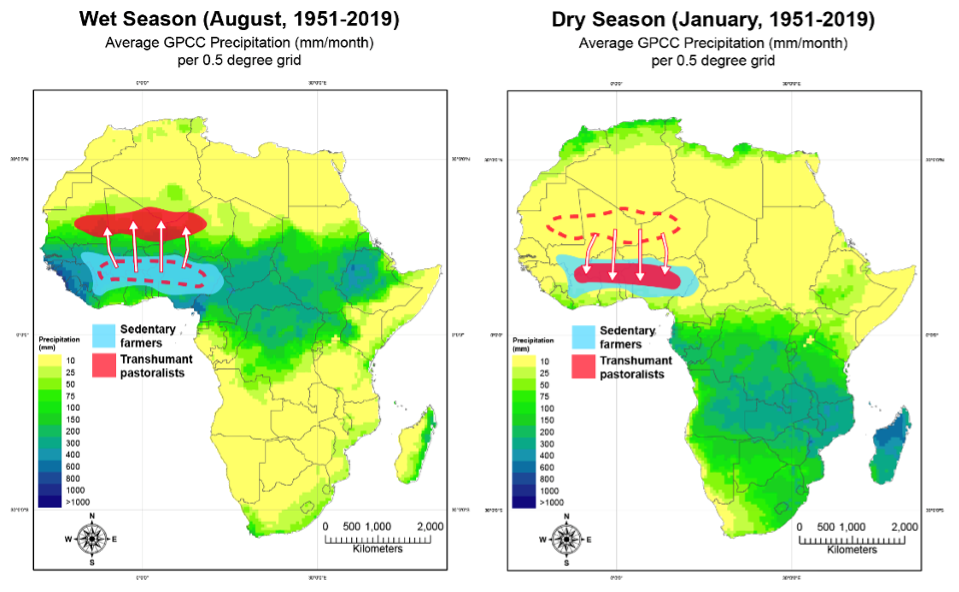A growing body of evidence suggests there are strong links between climate and conflict in both developed and developing countries. The effects of climate change, such as changes in temperature and precipitation, can increase the likelihood and intensity of conflict and violence.
An influential paper, published in 2015, synthesised 55 studies and found that changes in temperatures and precipitation patterns increase the risk of conflict: every 1 degree Celsius increase in temperature increases conflict between individuals (for example, assault, murder) by 2.4% and conflict between groups (for example, riots, civil war) by 11.3%.
Given that developing countries in tropical regions will likely experience the biggest rise in hot days due to climate change, this adds yet another dimension to the climate change burden carried by low-income countries. The 10 countries most vulnerable to climate change identified by the University of Notre Dame’s index are all dealing with armed conflict. Seven of them are also included on the International Rescue Committee’s list of countries with humanitarian crises most likely to deteriorate in 2021.
More recent regional studies have also shown a strong relationship between climate and conflict. A 2017 IGC study using data from Africa estimates a one standard deviation increase in temperature causes a 10.8% average increase in conflict incidents and 16.2% average increase in the violent crime rate.
What does climate-related conflict look like?
While the projections referenced above estimate the degree to which climate change impacts conflict at a high level, a new study by Eoin F. McGuirk and Nathan Nunn looks at how this type of conflict plays out among two groups in Africa – herders who migrate seasonally and farmers.
When there is not enough rainfall in a given year, not enough plants grow on grazing lands to feed herders’ livestock during the wet season. Herders are therefore forced to migrate to farmers’ lands before the dry season begins.
Figure: The seasonal movements of herder groups

Source: McGuirk & Nunn (2021) on VoxDev.org.
“If they arrive before the harvest, their animals may eat or trample crops, or otherwise generate competition for scarce resources such as water or pasture. This can lead to disputes that eventually escalate into violent clashes,” according to the researchers.
First, the study finds that generally there are more incidents of conflict in areas surrounding groups of herders who move seasonally. Second, the findings show that a typical, detrimental drop in rainfall experienced by a herder group increases the conflict risk in nearby farm lands by 35%. The researchers find no impact on conflict if a non-herder group experiences the same drop in rainfall.
Another recent study using data from Africa finds a 1 degree Celsius temperature increase leads to a 54% increase in the probability of conflict in places where there are both farmers and herders, versus a 17% increase in places where those two groups don’t co-exist.
These findings show that when estimating the impacts of climate change on conflict, it is important for researchers to consider how weather shocks in one location can spark conflict in another location.
A ‘threat multiplier’
To answer the question posed in the title of this blog, ‘does climate change cause conflict?’, the short answer is: not directly. Unlike politics and a history of conflict, the effects of climate change are not the main predictors of conflict. However, they are considered ‘threat multipliers’ which intensify existing conflict patterns – such as between migrating herders and farmers. Climate shocks like changes in precipitation and rises in temperature can make it more likely for conflict and violence to occur and to be more intense.
Furthermore, the relationship between climate change and conflict is complicated by the impacts of climate change on poverty, mental health, food security, and migration. While evidence is beginning to emerge, much more research is needed on these fronts. Another important area for future research is the role of climate adaptation in reducing the effects of climate on conflict. Social protection and agricultural technology, for example, hold much promise in helping countries adapt to climate change, and potentially in mitigating climate-related conflict.
Editor’s note: This blog is part of IGC’s sustainable growth series.


